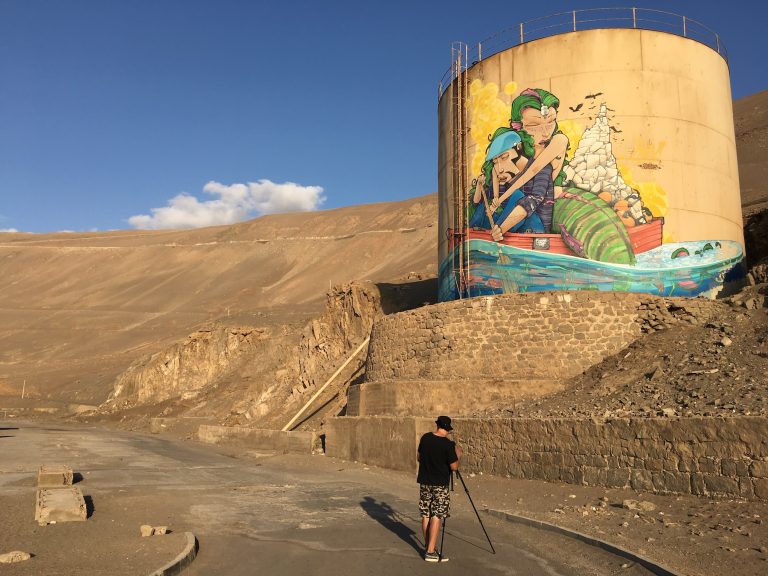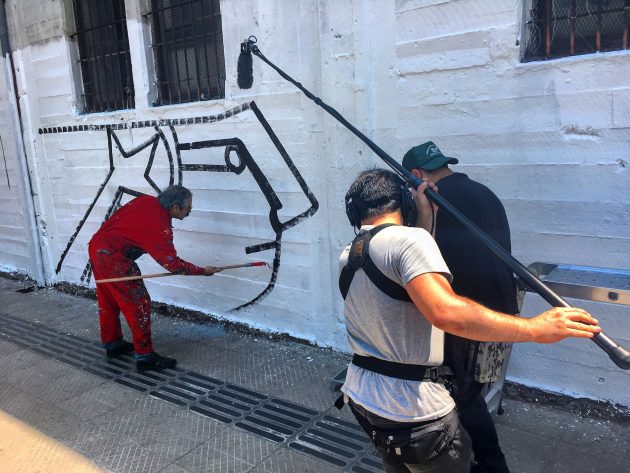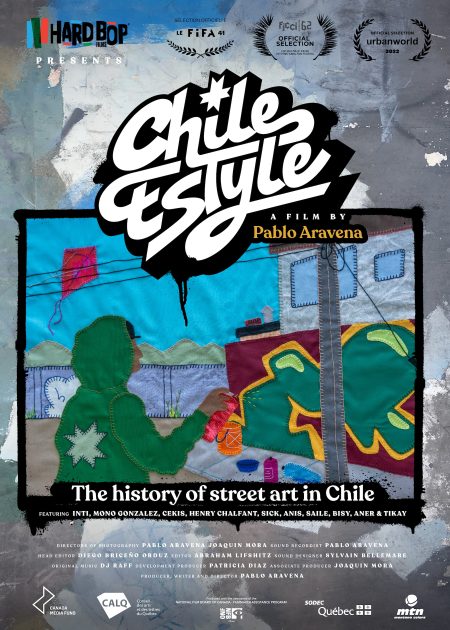
‘Chile Estyle’ Uses Street Art to Tell the Stories of a Diverse Nation
01 August, 2024A busy street in Antofagasta, a city in the north of Chile around 1,110 km north of Santiago. An artist quietly works with a mix of paints and brushes. He has the Pacific ocean to his back, and a flight of stairs as his canvas. A dark blue outline is followed by a brush of bright blue. Eyes, hair, and a face take shape. The artist Esec reveals to us a multilevel mosaic, which he titles ‘Escalera de la tolerancia’ or ‘Staircase of tolerance’.
This is one of many stops on our tour across Chile in Pablo Aravena’s documentary ‘Chile Estyle’. The film is a dazzling display of street art in the country, showcasing artistic expressions that range from tags to mural art. Set to a hip-hop soundtrack by a pioneer of the genre in Chile, London-based DJ Raff, the documentary shows us how a nation is using street art to tell its many stories. “Chile estyle is folklore on the walls,” Esec tell us, “it’s how the community expresses itself”.
Chile’s street art roots go back decades. Mono Gonzalez, the master of Chilean urban mural movement, began painting in the 1960s during the campaign for the presidency of Salvador Allende. “The system assigns a function to public spaces,” Mono tells us in the film, “This is a square, this is a school, a library. You’re not supposed to change these functions. But we had the opposite view… From 1968 to 4 September 1970, all of Chile was covered in paint. Even after Allende won, this continued. We had a society to build!”
All of this changed when the dictatorship of Augusto Pinochet took power in a bloody coup in 1973. Chile was transformed by neoliberal policies that privatised and shrunk the State, and by politics that banned criticism and free speech against the regime.
Then during the dictatorship, in the 1980s, hip-hop came along, and it was a perfect tool of expression. Films like Breakin’ and Beat Street started a craze in breakdancing with the rise of the B-Boys. Beat Street showed graffiti on screen, which renewed a passion for street art and influenced a new generation of artists, including DJ Raff and his contemporary, the now legendary musician Ana Tijoux, who grew up in France with her exiled Chilean parents.
Director Pablo Aravena grew up seeing the mural art in Chile during the protests against the dictatorship. Moving to Canada as a child, he went on to study at film school in Montréal. In 2005, he made Next: A Primer on Urban Painting, which explored graffiti-based art around the world including in Brazil. But a film that focussed just on the Chilean scene wasn’t planned until a chance question. Aravena tells me, “I was showing the film to a packed room at the Santiago International Film Festival in 2007. Then in the Q&A a friend of mine asked, ‘how come we’re not in it, how come Chile’s not in it? You’re Chilean!’ It was essentially because I’d left in 1985. I had left Chile, and I missed the entry point of those films and the B-Boys. There was a whole development, I kind of missed it all”.

Aravena visited Chile and began to research the street art movement there. “There was a lightbulb moment with a realisation of the whole muralist movement. I realised that we have this long history. When you speak to most people, they’ll say that it started in Paris in 1968 with the students doing stencils and writing poems. Then what we now call graffiti developed in the US in the 1970s. I was like, we were doing that in our country, a country that was very far away, separated by the mountains and the oceans. At the same time, there was also a mural movement in Mexico. So, Chile and Latin America were doing the same thing, using the street as a medium”.
Artists who came back to Chile in the early 1990s after the dictatorship brought their style and influences from diverse places such as Berlin, Paris and New York. In the film, Cekis, considered to be one of the founders of the graffiti scene in Chile, leads us down narrow alleyways in downtown Santiago, to where Chile’s first graffiti Hall of Fame once stood. Many of the early artists who went there to paint have since gone global and now exhibit their work to huge fame.
Aravena’s documentary showcases work that is taking place today, art which focuses on the many different political and social issues across Chile. We travel south to meet Aner and Tikay, a couple who use their art to paint the struggles of First Nation peoples. We head to Polanco, a working-class neighbourhood in Valparaiso, where a community graffiti project is transforming an area that rarely makes it into the postcards of the seaside city. Bisy, who leads the project, works within the community and uses art as a form of urban and social revitalisation, “graffiti is political and is activism,” she comments, “it’s a form of inclusion, prevention and also celebration”.

In 2019, an uprising known in Chile as the estallido social was triggered by university students in a protest against the cost of living, which then developed into wider demonstrations against the political and economic system that was put in place by the dictatorship, and which has led to huge inequalities throughout Chile.
“The film is about identity,” Pablo says, “The film was shot up until 2017 before the estallido social, where all these identities: native, feminist, regional in Chile just exploded and wanted to be heard. Artists were painting those voices on the walls before that, they were ahead of the game.”
Chile Estyle is a beautifully shot documentary that gives us a portrait of an artistic explosion happening across Chile, and which uses the street to tell the stories of a diverse nation.
Chile Estyle screenings:
Bristol | Tuesday 15th October at Papaya Festival + Q&A with Dir. Pablo Aravena
Manchester | 6th November at Cultplex + Q&A with Dir. Pablo Aravena
More on the film here: https://www.chileestyle.com/
Follow Sounds and Colours: Facebook / Twitter / Instagram / Mixcloud / Soundcloud / Bandcamp
Subscribe to the Sounds and Colours Newsletter for regular updates, news and competitions bringing the best of Latin American culture direct to your Inbox.

